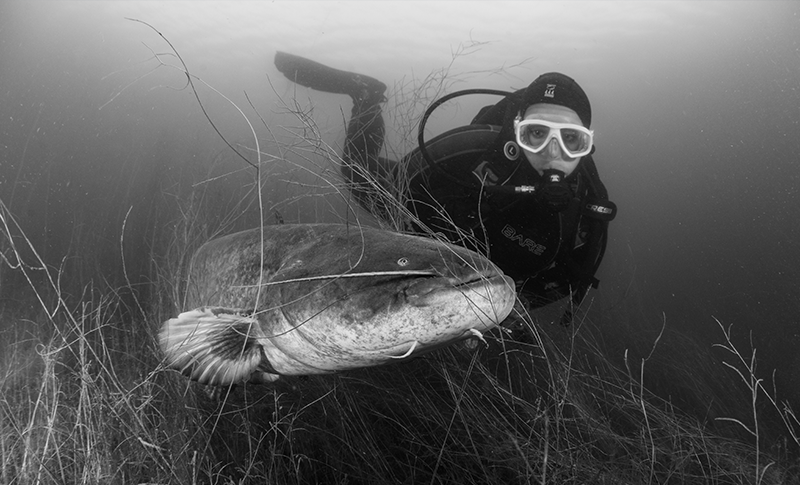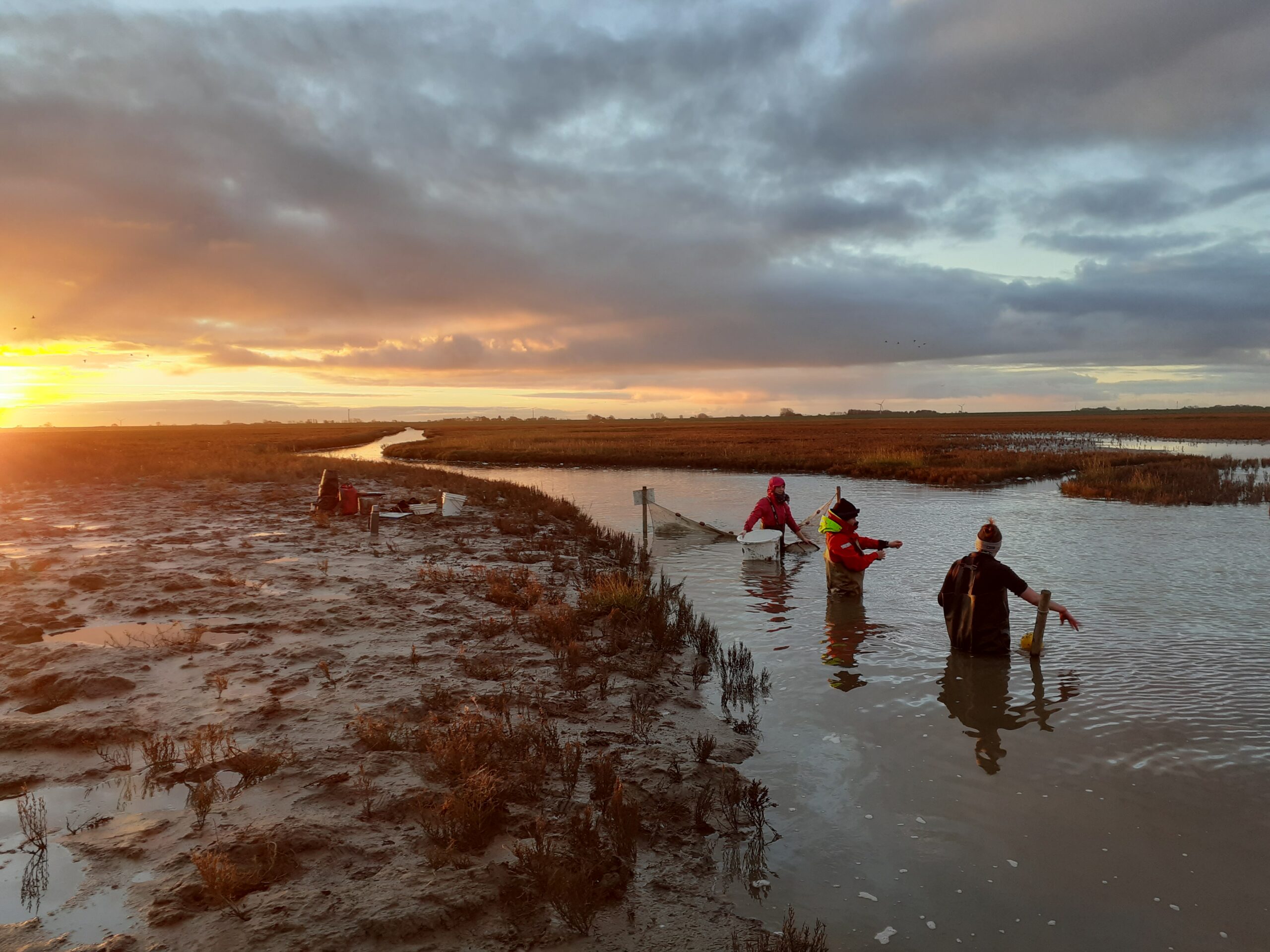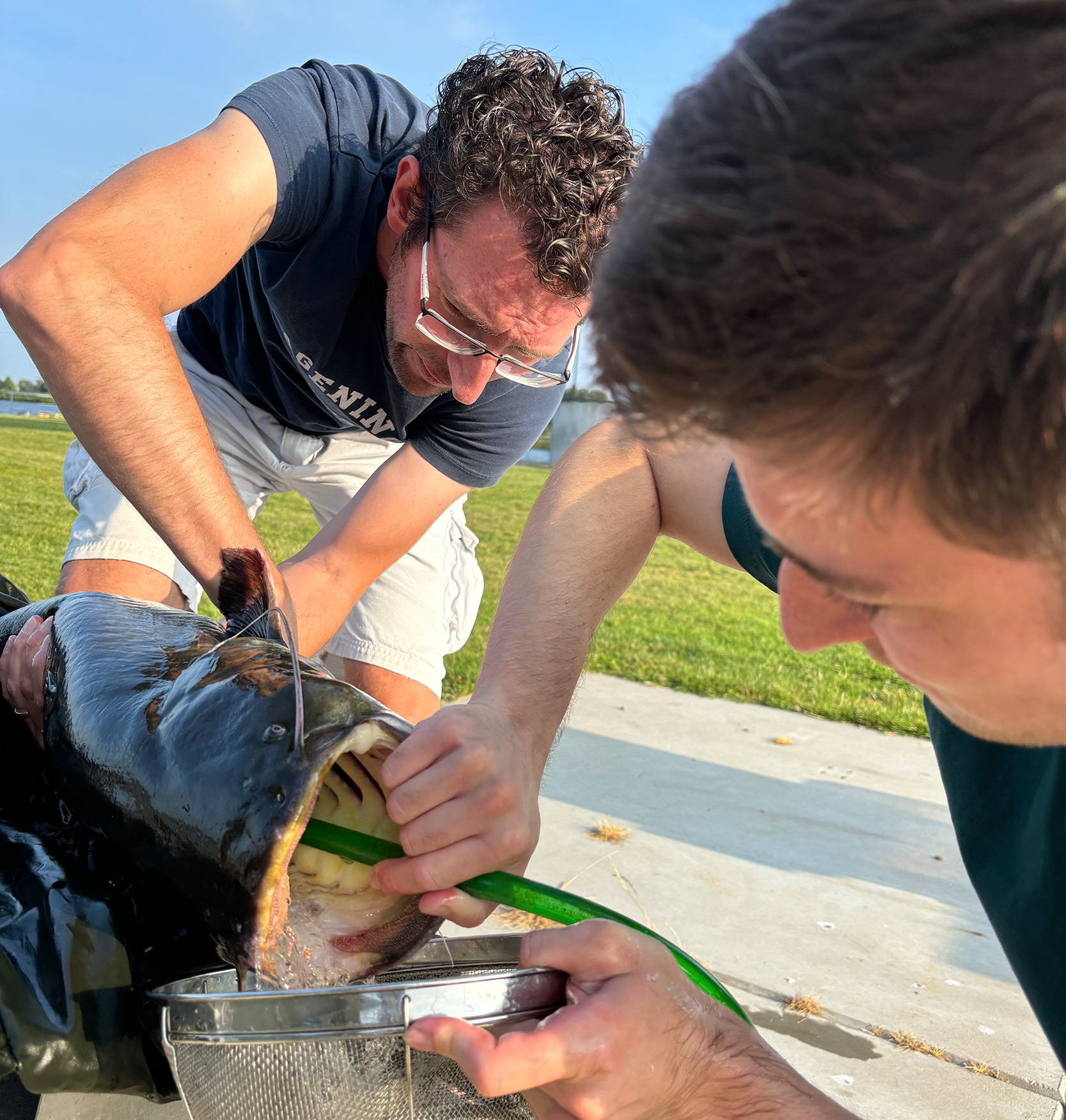The European catfish being caught by anglers in Dutch waters are getting bigger and bigger. What’s going on underwater?
The European catfish (Siluris glanis, also known as the sheatfish) has always been the largest freshwater fish in the Netherlands. But something odd seems to be going on, because ever larger catfish have been caught lately: it is raining record catches. Early last month yet another new record was set, with a catfish that was officially measured at 243 centimetres, making it the biggest catfish ever caught in the Benelux.
The biggest catfish Sophie Neitzel has caught so far is slightly smaller. But it’s still an impressive size, and more than a head taller than her at 193 centimetres – she is a modest 163 centimetres herself. Neitzel is a project manager at Wageningen Marine Research and a passionate angler and diver in her spare time. In the angling world she is known as one of the crack catfish anglers of the Netherlands. In that capacity she already made it to an episode of the fishing channel VisTV and even the NOS news programme got hold of her.
So exciting
Without a doubt, Neitzel has a thing about big catfish. She likes catching them, but what she enjoys even more is to seek them out in their natural habitat, diving into the most beautiful waters in the Netherlands. Not that these fish are easy to find. But after the many thousands of hours that Neitzel has spent sitting with her rod observing them, she has developed a good eye for potential catfish hotspots. She knows exactly what to look for. ‘Catching a big catfish is fun, but the process leading up to it is at least as exciting’, she says. ‘The catfish code is not easy to crack. It takes quite a bit of prior research to locate where a big fish might be. When I then go out on the water with my fishing kayak and fish finder (a device that ‘scans’ a column of water with sonar-like signals, showing the depth and any fish present, ed.), it’s so exciting. Just like a video game, but then for real.’
Warmer water
No specific research is currently being done on the European catfish, as far as Neitzel knows. ‘Although we researchers do come across the fish from time to time during fish stock sampling or fish migration projects,’ she adds. These are the ‘smaller’ catfish. Because although the large specimens are seen more often these days, they are still unusual.
They take anything they can swallow in one go
Neitzel, who is a biologist, does have an explanation for the way this fish species has flourished so much recently that record after record has been broken: the warming of the Dutch waters. This is good for reproduction – catfish only spawn at a temperature above 18°C – and it’s good for the food supply as the catfish’s food thrives in warmer water too. And because catfish grow fairly quickly, with such an abundance of food it does not take decades for them to grow to a length of over two metres – although Neitzel suspects that the real whoppers are probably already quite old.
Intimidating
Young catfish eat mostly small aquatic animals: larvae, water fleas, small fish and crustaceans. Their menu grows as they get older and bigger. ‘Adult catfish will eat anything they can get hold of, including their own species, birds and small mammals,’ in Neitzel’s experience. ‘As long as it’s something they can swallow in one go, because they don’t have sharp teeth.’
Humans don’t meet that criterion, so we should have little to fear from catfish. But if you think they are more afraid of us than we are of them, think again. ‘Especially in the spawning season, around May/June, catfish can be seriously intimidating’, says Neitzel. She speaks from experience: during a dive it was once made extremely clear to her that she was getting too close. ‘Catfish make a kind of nest to lay their eggs on, and then protect them fiercely.
The water is warming up, which is good for reproduction
If you accidentally get too close, they will try to chase you away by swimming towards you and banging against you. If you don’t retreat – which of course most people do, because a massive 100 kilo fish like that makes quite an impression – they won’t hesitate to bite you,’ she explains. And even though catfish have a kind of coarse sandpaper in their mouths rather than razor-sharp teeth, a bite can still cause a nasty graze. ‘If I have to grab a catfish by the mouth when I’m fishing, I always put on gloves first,’ says the catfish enthusiast.
Monstrous
Hooking such a large fish in Dutch waters is a special experience that is reserved for a handful of people. Neitzel makes it even more special by secretly returning to these spots later with diving equipment. Of course, she does not share the exact locations –anglers always keep their best spots to themselves. But one person who always goes along is her boyfriend Yoeri, who is a photographer. Thanks to his photos, these impressive and ever bigger inland ‘river monsters’ can be seen and admired by many people. Onwards to 250 centimetres.

 Sophie Neitzel – here with a catfish – is a project manager at Wageningen Marine Research and a passionate angler and diver in her spare time. Photo: Yoeri van Es
Sophie Neitzel – here with a catfish – is a project manager at Wageningen Marine Research and a passionate angler and diver in her spare time. Photo: Yoeri van Es 

